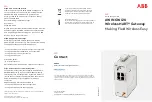
1 PRODUCT OVERVIEW
The Avocent® Universal Management Gateway appliance serves as a single point for secure local and remote access and
administration of target devices. The Avocent® Universal Management Gateway appliance supports secure remote data
center management and out-of-band management of IT assets from any location worldwide. It provides keyboard, video
and mouse (KVM) capabilities and can also remotely perform server management tasks, including power control and
console access, on managed target devices. Multiple administrators can be logged into the appliance at the same time and
can use the web user interface (UI), the command line interface (CLI) or DSView™ 4 management software to access and
configure the appliance.
NOTE: All instances of DSView™ software in this document refer to DSView™ software version 4.5 or higher.
The Avocent® Universal Management Gateway appliance combines KVM over IP, Service Processor Management (SPM)
and access and serial console management access. It gives you flexible target device management control and secure
remote access from anywhere at anytime.
1.1 Features and Benefits
1.1.1 Secure access
You can securely access the appliance through the following local (analog console port) and remote (digital IP) options:
•
LAN/WAN IP network connection.
•
Serial target device connection. An authorized user can make a Telnet, SSH v1, SSH v2 or raw connection to a
target device. For Telnet or SSH to be used for serial target device connections, the Telnet or SSH service
must be configured in the Security Profile that is in effect.
•
Console connection. An administrator can log in either from a local terminal or from a computer with a terminal
emulation program that is connected to the console port and can use the CLI.
1.1.2 Autosense
The Avocent® Universal Management Gateway 2000 appliance has eight autosensing ports that can be used for either
service processor (SP) or serial connectivity and management. It has an additional 32 RJ45 ports which are intended solely
for SP connectivity and management. The Avocent® Universal Management Gateway 4000 and 6000 appliances have 40
autosensing ports that can be used for service processor (SP) or serial connectivity and management.
Ports that support autosensing are designated on the back of the appliance with a small turquoise line next to the port
number. Ports indicate which mode of operation is currently active with a green or amber connection LED. By default, all
ports capable of autosensing are in automode. It is recommended to leave the port set to autosense. This is indicated by
having both the green and amber LEDs illuminated. If a port is statically set to one of the two modes, the corresponding
LED will be the only one illuminated.
Figure 1.1 Autosensing Port
Network and serial mode
The autosensing ports can operate in network or serial mode. Each major mode has sub modes called port classes. The
network port class is for network or SP connections. The port will autosense network targets but will need to be manually
configured for SP connected targets. The serial port class is for console connections or PDU connections. By default, the
serial port class will autosense to a console connection and will need to be manually configured for a Power Distribution Unit
(PDU) connection. The ports will autosense and switch to the appropriate mode depending on the target attached to the
appliance.
Vertiv
| Avocent® Universal Management Gateway Appliance Installer/User Guide |
1








































